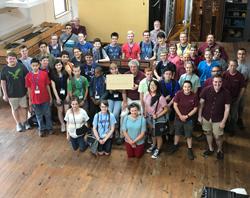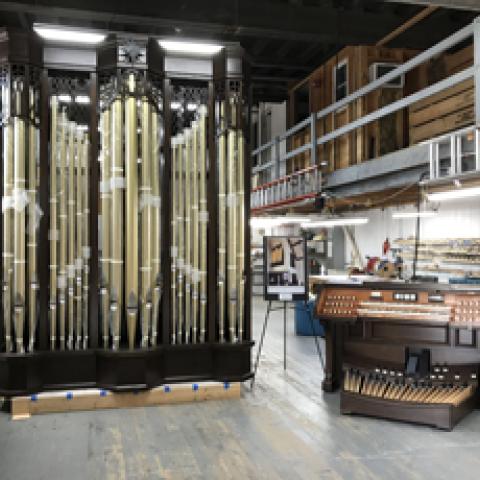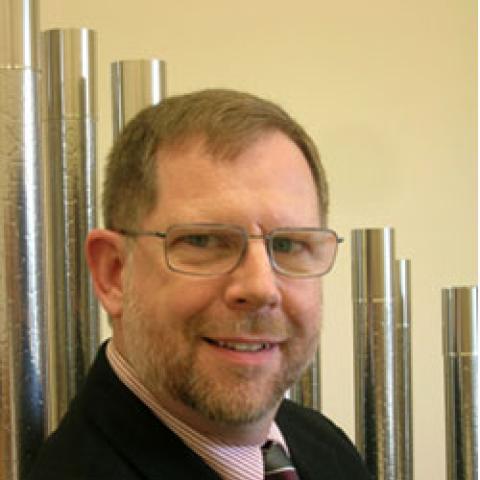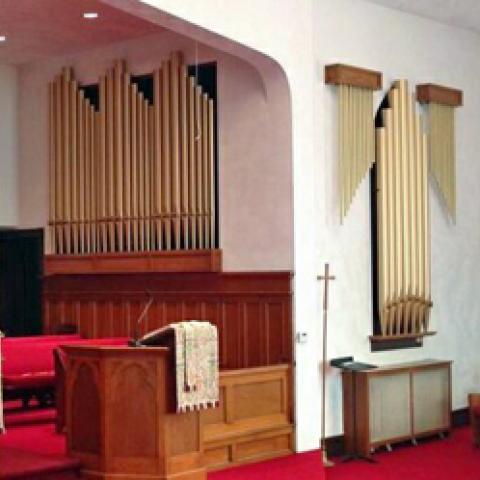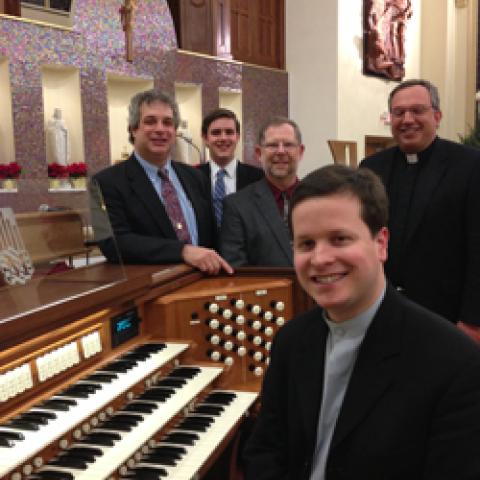R. E. Coleberd
Introduction
Pipe organ building in America today, as portrayed in the music media, is described exclusively as the crafting of new instruments, some with mechanical action and nearly all with carved or gilded cases. This is understandable given the news value of new instruments, but it is nonetheless unfortunate because it ignores a vital segment of organbuilding today: the restoration, rebuilding, refurbishing, updating, and modernizing of existing instruments as well as the building of new instruments from recycled and new material. This activity is primarily the work of individuals and small firms, unsung heroes in the spectrum of organbuilding today. Their work is especially important for two reasons: it speaks to the ongoing primacy of the King of Instruments as the time-honored musical medium in a house of worship, and the determination of congregations, recognizing this fact, to preserve and promote the pipe organ for present and future generations.
In 1966 the author published, in these pages, “The Place of the Small Builder in the American Organ Industry.” His comment that the independent builder “may well assume increasing importance in the future of the pipe organ and the organ industry”1 was perhaps prophetic of the situation today. In many ways this narrative is a continuation and update of that article. Forty years ago the pipe organ industry was dominated by the major builders, whose work accounted for 80% of the new instruments in a market where the discarding and replacement of older instruments was a major portion of the work. Today the situation is vastly different. The market is now only a shadow of its former self. Several major builders have folded, unable to continue under greatly diminished factory production; buyers have welcomed the electronic instrument amid drastically diminished mainline church membership and budgets; and the academic market, with certain notable exceptions, is gone because colleges and universities are market-driven and direct capital resources to enrollment demand.
Yet, organbuilding continues, and pipe organs will always be built in this country and the world over. An important segment of this effort, now demanding recognition, is the work of talented individuals, working alone and in collaboration with other artisans, to craft instruments of singular artistic merit in accordance with public recognition today that a pipe organ is a work of art and the work of an artist. In a statement in 1966 prophetic of the situation today, Robert J. Reich, founder and now retired president of the Andover Organ Company, an early participant in the tracker organ revival in America, stated his philosophy of organbuilding as “the craftsman’s approach to construction and the musician’s approach to tone.”2 Musical interest and skill begin early and often with other instruments, while craftsmanship is acquired through formal and informal training.
This article describes the career of D. Steuart Goodwin: the experiences and individuals who shaped his philosophy of organbuilding, details of several instruments in his opus list, and his contemporary voicing and tonal finishing assignments. Steuart has won the admiration and respect of organ committees, organists, and builders as evidenced by his assignments across the country. Jack Bethards, president of Schoenstein Organbuilders, calls Goodwin a genius:
There is no other way to explain his brilliance in so many fields. Steuart combines the well-honed skill of a master craftsman with the cultivated taste and sensitivity of a fine artist. He has a real gift for design both visual and tonal. He is a musician through and through. His touch with pipes is magical. With ease and efficiency, he can bring the best musical quality out of just about any set of pipes.3
Said Manuel Rosales of Rosales Organbuilders:
My friend and colleague Steuart Goodwin is a rare individual, whose organ building talents combine great skill, good taste, and economy of resources. He is equally at home with visual design, tonal finishing, and hands-on organbuilding. His love of the craft is exemplified by the warm and inviting sounds of his new instruments and many revoicing projects. He and his work continue to be a source of personal and professional inspiration for me, his coworkers, and his clients.4
Early life and education
Donald Steuart Goodwin, Jr. was born on April 9, 1942 in Riverside, California, the son of a building contractor who sang in college musical productions, and a sometime public school teacher and housewife who taught piano privately.5 His grandfather, Phillip Goodwin, taught violin in Redlands, California, and played in a string quartet. Steuart’s folks met at the University of Redlands, a Baptist liberal arts college long known for its fine musical program. Arthur Poister taught organ there in the 1920s when a celebrated four-manual, 54-rank Casavant organ, recently restored and updated, was installed in Memorial Chapel. The organ program at Redlands is primarily associated with Leslie Spelman (1903–2000), a nationally known teacher and pedagogue who joined the faculty in 1937.6
Steuart’s musical interests began early; his 96-year-old mother recalls that he could carry a tune at the age of two. He began cornet lessons in the fourth grade and enrolled in the band at Lincoln School in Riverside. He recalls as a youngster asking his mother about the Estey pipe organ in the family’s Methodist church, but what really turned him on was when, at the age of fourteen, he and his father saw Disney’s 20,000 Leagues under the Sea and heard Captain Nemo play Bach’s Toccata and Fugue in D minor. “I went home and played my older sister Jane’s recording over and over, checked out books at the library on organbuilding, and from that time on I was permanently ‘hooked’,” he says.7
Eager to study organ, Steuart approached Roberta Bitgood, organist at Calvary Presbyterian Church in Riverside, who had studied organ with Clarence Dickinson and who was later national president of the AGO. She suggested he begin with a year of piano instruction, which he did, before studying with her for two years, in the 11th and 12th grades.8 While in high school, his future organbuilding career began when he installed a three-rank Robert Morton theatre organ in his family’s garage. His theatre organ interest continued and became part of his work.
In 1959 he matriculated in the music program at the University of Redlands, majoring in composition under Wayne Bohrnstedt, having already written two chorale preludes for organ and a sonata for woodwind quintet. He sang in the University Choir his freshman year and played in the concert band all four years. In 1961, his sophomore year, he won the $800 first prize in the Forest Lawn Foundation Writing Awards Contest with an essay entitled, “The Organ Builder Finds His Place.”9 During Goodwin’s junior year, the band director persuaded three trumpeters to switch to French horn, which was a wise move for Steuart as he went on to play horn for 13 seasons in the University-Community Symphony—until it was converted to all union professionals.10 In recent years he has played French horn in a woodwind quintet and in the Redlands Fourth of July Band.
Goodwin studied organ at Redlands with Raymond Boese (1924–1988), who came to Redlands in 1961 to join his former teacher and now colleague Leslie Spelman in the music department.11 By his junior year, Steuart had become dissatisfied with the Wicks, Harry Hall (New Haven), and Robert Morton practice organs on campus, all dated and woefully inadequate for modern pedagogy and performance. He convinced the school that they needed a tracker instrument, having been listening avidly to recordings by E. Power Biggs playing and narrating tracker organs in Europe. Scouring classified ads in The Diapason, he found an 1870s George Stevens (Cambridge) instrument for sale by Nelson Barden.12 After months of negotiating with school officials, the parties reached an agreement, whereby the school would pay for the instrument and shipping, and Goodwin would install it in Watchorn Hall. In gratitude for this effort, the school awarded him three credits toward graduation.13 Steuart’s senior recital at Redlands, featuring his own compositions, included a Trio for horn, violin and piano, a Quintet for woodwinds, a Sonata for organ, and a Suite for brass.14 He graduated with a bachelor’s degree in music in 1964.
During this period he built a small organ with paper pipes on which he could play a Haydn clock piece (see photos). Then, in a remarkable coincidence, E. Power Biggs played a recital on the Casavant in the Redlands chapel. Goodwin showed him the paper-pipes organ, and Biggs, unprompted, played that particular Haydn piece on it. Recognizing Steuart’s interest and promise, Biggs suggested that he apply for a Fulbright scholarship to study organbuilding in Europe. In his letter of recommendation to the Institute of International Education, Biggs wrote:
Steuart Goodwin has the possibly-unusual wish to study organ building in Europe, preferably in the center of fine organs, old and new, which is Holland. . . . I cannot think of anyone who would be more qualified for a Fulbright grant than Steuart Goodwin, nor anyone who could make better use of the opportunity. Already at Redlands he has proved his theoretical grasp of the subject, and his ability to transform ideas into action, and practical results.”15
The choice for the Fulbright year abroad for Goodwin, 1964–65, was between Flentrop and von Beckerath. He chose Flentrop because most Hollanders speak English, and his German was very limited. His experience was mixed, probably unlike that of most Fulbright scholars, he comments. He was assigned to the pipe shop where he acquired pipemaking skills, but he had a brief run-in with Mr. Flentrop. Inadvertently interrupting a conference while trying to introduce himself, he was subsequently ushered into the maestro’s office and severely scolded. “If we had been Germans you would have been thrown out immediately,” Flentrop said, adding, “you can stay here if you will simply work in the pipe shop and keep quiet. Try to observe the Dutch boys and behave as they do.”16 This meant never asking questions—asking questions was unheard of for an apprentice. He was never allowed to see the company woodworking shop in Koog an de Zaan. He did, however, make several sets of pipes for the Rugwerk division of the large four-manual Flentrop instrument in St. Mark’s Episcopal Cathedral in Seattle.
At the end of his Flentrop sojourn, Goodwin met with Dr. Martin Vente, internationally renowned organ historian and scholar, who provided him with a map locating important Dutch organs nearby. He spent several days traveling by train and bicycle to see many of them. The one that deeply impressed him and would greatly influence his emerging tonal philosophy and mark his work today was at the Oude Kerk in Amsterdam, ironically dismissed by Flentrop as too romantic.17 “I suffered something of a cognitive dissonance over this, since Flentrop represented the Neo-Baroque ideal espoused by Biggs,” Steuart comments. “I was supposed to like the Baroque, but found myself more deeply moved by the 19th-century voluptuousness of this instrument.”18
Returning from Holland, he opened a small shop in San Bernardino, soon welcoming an opportunity to move to a larger, well-equipped facility nearby, the former Fletcher Planing Mill, whose owner was retiring. There he built three small tracker organs and rebuilt two. Opus 1, a six-rank, two-manual tracker for the Fine Arts building at the University of Redlands, was originally purchased by the organ professor, Raymond Boese. He sold his interest to the university, which paid Steuart a nominal sum and traded him the Hall and Morton instruments. The stoplist comprised a Gemshorn 8' and Principal 2' on Manual I, a Gedeckt 8' and Rohrflute 4' on Manual II, and a 16' Bourdon and 4' Choral Bass on the Pedal, plus the usual couplers. His Opus 2, 1972, was an 11-rank, two-manual tracker for the Fourth Ward Mormon Church in Riverside. In 1973 he built Opus 3, a one-manual, four-rank rental organ. This instrument was used at the Memorial Chapel, University of Redlands, for the Feast of Lights one year, and has been rented by the Ambassador Auditorium and by the Los Angeles Philharmonic and Chamber Orchestras for use in the Dorothy Chandler Pavilion and Hollywood Bowl. It is now in a home in Altadena.19 Reflecting on Opus 1 and 2, he describes this period as his Biggs, Flentrop, Schlicker days and says:
In each of these first two small organs there was to be only one independent eight-foot rank on the Great. It needed to work as an accompanimental sound as well as the foundation for a small principal chorus. At St. Bavo in Holland, I had heard an unforgettably warm tapered hybrid stop called ‘Barpijp,’ which inspired me to use a Gemshorn instead of a less flexible Principal or Stopped Flute. I experimented with using Gemshorns in a Swell division, but soon grew out of that and came to greatly prefer real string tone.20
During this long period of apprenticeship including travel, reading, talking with organists and organbuilders, and perhaps most importantly listening—to records and instruments—his philosophy of organbuilding and tonal ideals were taking shape, and he made certain fundamental decisions about the direction of his emerging career. He determined that he wanted to work individually, expressing his own artistic concepts, free from the constraints of established large builders where opinions differ, compromises are often the rule, and mimicking some academic paradigm or current fashion is required. His primary goal became to achieve “a certain populist sensibility when it comes to providing what will please congregations and audiences.”21 “Many times I have wondered whether to stay [in Redlands], but if I were to work for a nationally known organ builder, I would lose the independence I have here,” he told the San Bernardino Sun-Telegram in 1978.22 And as he told columnist Nelda Stuck of the Redlands Daily Facts in 1987, “There is no area of music I can think of where there are so many factions and arguments about style,” referring to Baroque vs. Romantic pipe organs and tracker vs. electro-pneumatic action.23
Trinity Episcopal Church
Opus 4, an instrument in which he takes particular pride, illustrates the scope of Goodwin’s early work and evidences his talents in voicing and case designs: the 35-rank, 31 speaking stops, three-manual tracker in Trinity Episcopal Church, Redlands, California. Originally built in 1853 by the prominent New York City builder George Jardine for the First Presbyterian Church in Rome, New York, it was acquired by St. Michael’s Ukrainian Catholic Church in Rome in 1908, where it was rebuilt by C. E. Morey of Utica, New York. Meanwhile, Trinity Church in Redlands installed a three-manual Austin, Opus 111, in 1904.24
The Jardine-Morey organ was acquired through the Organ Clearing House, and over a period of 19 months was rebuilt, together with parts of the Austin, as an eclectic instrument combining 802 original and 838 new pipes for a total of 1640 (see 1975 stoplist). This project illustrates the amalgamation of older and new material into an instrument of singular artistic merit. Through a vision of what these two instruments together could and should be, Goodwin was able to “see” how the skilful blending of solo and foundation stops would produce vibrant and colorful choruses and ensembles. This organ fulfills Goodwin’s conviction that there has to be a visual-sonic relationship, i.e., a relationship between what you see and what you hear (see photos). “A pipe organ should be capable of choruses, amalgams of many tones from many pipes, producing a rich, subtly infused musical statement,” he told Dennis Tristram, a reporter for the Riverside Daily Press newspaper.25
In an arched nave opening three lancet arches were formed of oak and filled with 15 newly painted and stenciled dummy pipes retained from the Austin façade. Trinity Church has been described as an example of 19th-century Anglo-American architecture, which led to the chancel case design that Steuart based on the case at Peterborough Cathedral in England designed by Arthur George Hill (1857–1923), described as one of the great Victorian organ builders.26
During the construction of this organ Steuart joined the choir, and ultimately became confirmed as a member of the church. This has provided an unusual opportunity for the builder to repeatedly update and modify the instrument over many years, both tonally and mechanically. The large single bellows was replaced a number of years ago with individual regulators for each division, resulting in steadier wind and the possibility of divisional tremulants. More recently electric stop and combination actions were installed, several ranks were added and others moved around, giving the organ more scope and a more English flavor (see 2004 stoplist).
Tonal evolution
Goodwin’s work is especially noteworthy because it represents the crafting of instruments embracing the required resources in tonal families and pitches capable of performing the great music of antiquity as well as today’s requirements, but one that is free from the strident and narrow definitions of Baroque, Neo-Baroque, North German, South German, or American Classic stoplists, scales, wind pressures, and voicing. These eclectic instruments, beginning with the work of individual artisans and small shops, have influenced a new style of organs, free from the prejudices against stops that in the 1950s were considered “old hat” and indicative of an obsolete organ that should be replaced. Formerly verboten stops—the Melodia, Cornopean, Harmonic Flute, and Vox Humana, for example—are now recognized for their intrinsic musical content and are often embraced without hesitation by many builders who incorporate them in their instruments, confident of their ongoing musical value. This approach extends to the use of wooden flue work and open flutes, a defining characteristic of American organbuilding from the very beginning, but largely eschewed in the 1950s in favor of metal ranks and tapered, half-tapered, stopped, and chimneyed stops.
Steuart’s Opus 5 was a restoration for St. Mark’s Episcopal Church in Upland, California, of E. & G. G. Hook & Hastings’ Opus 734, 1873, formerly located in the First Baptist Church in Bloomington, Illinois. Opus 6 is a four-rank, two-manual house organ, featuring an ornate case and suspended action (see photo).27 This is an early example of an elaborate 18th-century case as built by the Dutch and Germans and pioneered by John Brombaugh in America at a time when the European builders were building modern cases in this country. In 1978, in a brief detour from mechanical action, Steuart built a two-manual, six-rank unit organ with electric action for the United Methodist Church in Yucaipa, California. “I never built another unit organ for a church,” he comments. “I am enthusiastic about the unit principle for a theatre organ, but you can easily overdo it in church work if you are concerned about good tone.”28
In 1978, David Dixon, who met Manuel Rosales at Schlicker in Buffalo and who became his partner in Los Angeles (and who later returned to Schlicker before his untimely death at an early age), approached Steuart about working for them, which he elected to do. He assisted in their introduction to tracker work, in designing cases, traded organ philosophy with Manuel, and acquired some refinements in voicing technique from Dixon.
Opus 8, a 13-rank, two-manual electropneumatic action organ for the First Baptist Church in Colton, California in 1979, marked a major milestone in Goodwin’s tonal philosophy, and contains elements that characterize his later work. In earlier years he was interested in tracker action, but over time came to believe that even 11 ranks (Opus 2, Fourth Ward Chapel, L.D.S. Church, Riverside) in a tracker aren’t very flexible. He became convinced of the value of a unit Gedeckt stop, which he first used in Colton and subsequently on several 12- or 13-rank instruments (see stoplists for Colton and St. George’s Episcopal Church). He began searching for a small, flexible church organ design, and the unit Gedeckt was part of the answer. “I hit upon it almost by accident while contemplating for Colton how to best use a couple of pitman chests incorporating one unit chest,”29 he comments, adding:
“The concept begins, as usual, with a complete principal chorus, 8' through mixture, on the Great. Next, on the Swell, I use a pair of strings (real string tone, not hybrids), a medium-bright Trumpet, and (where space and finances permit) a 4' Principal or Fugara. Budgetary concerns generally limit independent pedal ranks to the ubiquitous 16' Bourdon. The Great also contains an open metal flute, which, in the Colton prototype, was originally part of an Aeolian house organ. The pipes looked ridiculous to one brought up on Neo-Baroque ideals. The heavily nicked mouths were cut-up two-thirds in a half circle, and, yet, when you blew on them they were magically beautiful. I began to realize that you couldn’t depend on what other people said was good, you had to trust your own ears.
“The 85 to 97 pipes of a Lieblich Gedeckt are located on a unit chest in the Swell box. This rank is made available at three pitches on the Great, six on the Swell, and four to six pitches on the Pedal. Importantly, the Gedeckt stop tabs on each division are grouped together to the right of the straight stops and couplers, and they are not affected by the couplers.
“This arrangement makes the structure of the tonal design quickly apparent to an organist, while simultaneously making registration practically goof-proof. For instance, it is impossible to mix the derived mutations on the Swell with the principal chorus on the Great. I settled on the Lieblich Gedeckt for the one unified rank because it blends well at all pitches and because the pitch-beats caused by an equal-tempered rank used at mutation pitches are only barely discernible.
“In an organ of only 12 or 13 ranks, one can make dozens of useful combinations and build ensembles suggesting a much larger instrument. For instance, on the Pedal the 51⁄3' through 2' pitches—when used with the Great chorus coupled—reinforce the 16' line and create the impression that there is a Pedal mixture. A solo Cornet effect can be registered as follows: couple the string and celeste to the Great and silence them on the Swell using the Unison Off. Then set a solo combination of Gedeckt pitches such as 8', 4', 22⁄3' and 13⁄5' on the Swell (tremulant optional).
“The point of all this is to provide excellent sound and unusual flexibility in a small church organ design. To keep these organs even more affordable, we incorporate many used parts and pipes. A brand new console shell is hardly a necessity when so many are available used. I like to put the money where it counts the most—in careful voicing and tonal finishing, new electronic relays, and high quality visual designs.”30
The discovery of the Aeolian open metal flute, quixotically called Flute Piano (apparently for people barely musical and certainly not organists) was to mark a milestone in Goodwin’s career. Placed in the Great of his instrument in Colton, it proved to be of such great value as both a solo and ensemble stop that it led him to incorporate 8¢ open flutes on that division routinely. Most instruments, having a Chimney Flute on the Great and Gedeckt on the Swell, don’t have the flexibility of an open 8' flute, an important color in his judgment, adding, “I voice it quietly in the bass and midrange and somewhat ascendant from middle C up so one rank can be used three ways: as an accompaniment stop in the left hand, a solo stop in the treble and a lighter foundation than a Diapason in a Principal chorus.”31
Perhaps the most impressive example is found at Holy Cross Church in Santa Cruz, California. Built in 1889 on the site of one of the famous Spanish Missions, Holy Cross is an imposing neo-Gothic brick building with splendid acoustics. Starting with a 13-rank A. B. Felgemaker tracker obtained through Alan Laufman and the Organ Clearing House, Goodwin added 10 ranks including an open metal flute, two mixtures, two chorus reeds and a string celeste (see before and after stoplists above right, and photo on page 28).
In 1995, Steuart installed his Opus 15, a remarkably cohesive two-manual and pedal organ of 12 ranks, featuring the unit Gedeckt and the 8' open flute discussed above in St. George’s Episcopal Church, Riverside (see stoplist on page 26, and photo left). The striking white oak case is accented with bronze moldings and padouk wood stripes.32
Voicing and tonal finishing
In 1980 Steuart became associated with the Schoenstein firm in San Francisco, which marked still another chapter in his career, one that would grow and distinguish his work today. He worked closely with Jack Bethards, Schoenstein president, in the major renovation of the epic Aeolian-Skinner organ in the Mormon Tabernacle in Salt Lake City, where he did most of the flue voicing. Bethards does extensive consulting coast-to-coast, and when he concludes that the major problem with an organ is inferior tonal work, he often recommends Steuart, who, working with his assistant Wendell Ballantyne, has had nationwide assignments: New York, Georgia, Texas, and North Carolina. Reworking an older instrument almost always begins with a sensitive new organist, and one job leads to another. This work typically involves removing sizzle and chiff, increasing foundation tone, repitching a mixture with new breaks, and replacing unsuitable pipes. With his fine reputation as a voicer and finisher, when prospects hear his work, they want the same thing. For example, Steuart’s current work at the Covenant Presbyterian Church in Charlotte, North Carolina, is the direct result of his work at Myers Park Baptist Church there. Goodwin’s recent theatre work includes voicing, in collaboration with Lynn Larsen, a large theatre and romantic instrument in the home of Adrian Phillips in Phoenix, Arizona, and completing a mostly seven-rank Wurlitzer organ in his own home in Highland. His much admired tonal work on the epic four-manual, 26-rank Wurlitzer in Plummer Auditorium, Fullerton, led to his election to the governing board of the Orange County Theatre Organ Society.33
Summary
In a varied career marked by many accomplishments, Steuart Goodwin represents the individual organbuilder, working alone or in collaboration with others, a vital segment in the spectrum of organbuilding in America today. Long neglected but deserving of greater recognition, the work of these persons may well assume greater significance in the future of the trade and the instrument. Beginning with a rich musical background, often both instrumental and vocal, which continues, they acquire the knowledge and skills of building the pipe organ through travel, reading, observation and apprenticeship. In their deep commitment to the King of Instruments, they gladly sacrifice more lucrative occupations. Today and tomorrow, amid the manifold and far-reaching changes in our culture, the majestic pipe organ is recognized as a work of art and the work of an artist. There can be no better example of this truth than the life and work of Steuart Goodwin.
Steuart Goodwin & Co. Opus List
1. 1970. Two-manual, six-rank tracker practice organ. Now in home of Dr. Harold Knight in Dallas, Texas.
2. 1972. Two-manual, 11-rank tracker, 4th Ward, Church of Jesus Christ of Latter-day Saints, Riverside, California.
3. 1974. One-manual, four-rank portable rental organ. Now in home of Bruce and Mary Elgin, Altadena, California.
4. 1976. Three-manual, 35-rank tracker, Trinity Episcopal Church, Redlands, California. With components of an 1852 Jardine from Rome, New York, obtained through the Organ Clearing House.
5. 1977. Two-manual, 17-rank tracker, St. Mark’s Episcopal Church, Upland, California. Rebuild of E. & G. G. Hook & Hastings #734, 1873, obtained through the Organ Clearing House.
6. 1978. Two-manual, four-rank practice organ in the home of Frances Olson, Mount Baldy Village, California.
7. 1978. Two-manual, six-rank unit organ, now in St. John’s Episcopal Church, Corona, California.
8. 1979. Two-manual, 13-rank electro-pneumatic, First Baptist Church, Colton, California.
9. 1984. Two-manual, 13-rank tracker, Our Lady of the Rosary Cathedral, San Bernardino, California. Rebuild of Moller #1701, 1913, obtained through the Organ Clearing House.
10. 1988. Two-manual, 23-rank tracker, Holy Cross Church, Santa Cruz, California. Based on A. B. Felgemaker #506, 1889, enlarged and considerably modified visually and tonally.
11. 1991. Two-manual, 11-rank, electric action, Stake Center, Church of Jesus Christ of Latter-day Saints, Simi Valley, California. Incorporates many pipes and parts of Moller #5482, 1928, obtained through the Organ Clearing House.
12. 1992. Two-manual, 13-rank electro-pneumatic, Fontana Community Church, Fontana, California. Incorporates console and many pipes from the church’s 1920s Spencer organ.
13. 1993. Three-manual, 38-rank, electric slider chests, First Christian Church, Pomona, California. Extensive tonal revisions. Based on Hook & Hastings #2240 with prior modifications and additions by Ken Simpson and Abbott & Sieker.
14. 1995. Two-manual, 19-rank, electric and electro-pneumatic, St. Timothy Lutheran Church, Lakewood, California.
15. 1995. Two-manual, 12-rank, electro-pneumatic, St. George’s Episcopal Church, Riverside, California.
Other work
The tonal finishing team of Steuart Goodwin and Wendell Ballantyne has done extensive work on organs in California, Georgia, North Carolina, New York, Texas and Utah.
Steuart has worked on many case design and voicing projects with Rosales Organbuilders and Schoenstein & Co. For photographs and details visit .
For research input and critical comments on earlier drafts of this paper, the author gratefully acknowledges: Edward Ballantyne, Jack Bethards, Ken W. List, Albert Neutel, Donald Olson, Michael Quimby, Robert Reich, Manuel Rosales, Jack Sievert, and R. E. Wagner.
